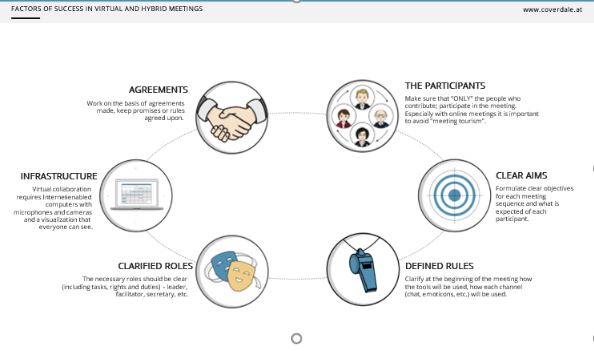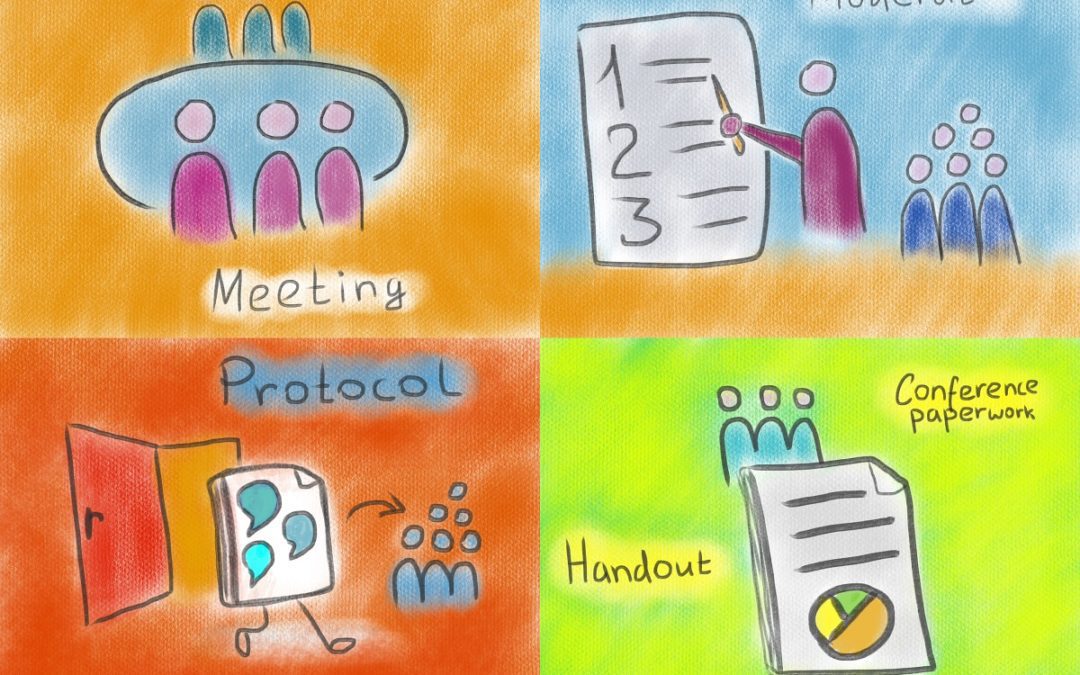The number of online meetings has increased dramatically in the last two years. Of course, we are noticing this ourselves. The number of remote events currently accounts for more than 50% of our working time.
During this time, we have adapted our way of working for remote events several times to work as efficiently and effectively as possible online.

The allocation of working time:
Those who design online meetings and workshops well can usually achieve at least the same output as in analogue meetings and workshops if some principles are taken into account:
- Traditionally, meetings start on the hour or half-hour. To ensure that all participants are present at the conference, start 5-10 minutes later. Participants who transfer from a follow-up meeting directly to your session have the opportunity to take a short break.
- Deliberately plan a method change every 30 minutes so that participants do not fall into “cinema mode”.
- After 90 minutes at the latest, take a break of at least 20 minutes, better 30 minutes, to continue again with fresh energy.
Open camera:
This is a nagging issue for many clients. People sit at computers that do not have an integrated camera or do not want their privacy disturbed. At the same time, working with an open camera creates a much better atmosphere, especially when discussing or working on something together.
- When sending out the appointment, you agree that you want to work with an open camera. Give guidance on setting up an optical background or activating the soft focus.
- If someone does not have a camera available at their workplace, remedy the situation by improving the equipment. In the short term, adding the company mobile phone on a tripod can also help.
- If point 1 and point 2 are not possible, provide a mobile barrier that participants can attach to their chairs.
Visualisation:
The productivity of a team in a workshop or meeting increases by leaps and bounds when it is interactive. In analogue settings, forms of visualisation that meet the needs of groups have become established in most organisations. Working with a flipchart, with moderation cards and post-it’s is now part of the analogue meeting and workshop standard. We also advocate using this form of visualisation in online sessions – but electronically.
- If you work analogously with presentations that are handed out to the participants at the start of the event or in advance, make sure that the participants also have these documents at their disposal in online meetings.
- If you work in analogue meetings with tools that allow everyone to work in real-time (e.g. OneNote), do the same online.
- If you need an interactive setting, equip yourself and your team with an online whiteboard with all the features you need during the workshop. For example, test Miro or Mural or similar tools in advance so that you as a facilitator can concentrate on the facilitation process.
- Offer your participants a 10-minute crash course when using the tool for the first time. Make sure that all participants can actively participate.
The number of participants:
In many organisations, it has become common practice to distribute an invitation to a meeting or workshop rather “widely” not to forget anyone “important”. People who may not have been on the inviting party’s radar are also added to the list by forwarding the date.
As a result, meetings often consist of active participants who can contribute to the topic and present people because it might be essential. We suggest a different approach for online meetings:
- Always send out an agenda stating what topics will be discussed and what contribution you expect from the invitees.
- Request the appointment of a decision-making substitute if the invited person is not available. Turn off the “forwarding” function of the meeting to have control over who has received an invitation.
- Avoid “overbooking” other people’s calendars; ask in advance if the date you have in mind is possible, or if not, who will appear as a substitute.
- Invite only the people who are necessary for the meeting. Determine who needs to be informed about the solution developed in the meeting and send the result to this group of people in advance. Ensure that after the conference or workshop, there is a record of the results promptly sent to the participants.
- Work with a process design that is adequate for the number of participants. Plan breakout sessions if necessary. Use the functionality of your conference software. (As a meeting organiser, you can open breakouts directly from the meeting. If this is not possible, set up parallel appointments if you want to do break out sessions).
When working online, the challenge for facilitators increases to analogue meetings. They need to develop a process and visualise it in advance on how you want to guide participants to achieve the desired output to ensure a smooth process. – e.g. a solution, a prototype or a package of measures.
We use electronic whiteboards on which the entire process is structured in advance. The blocks that we do not need are hidden for the participants. After each break, we unlock the next block.
If a process change is necessary, it is helpful for inexperienced facilitators to have a “backup” prepared that can be adjusted if necessary.
We wish you every success in trying out this new world that has come to stay.


Recent Comments